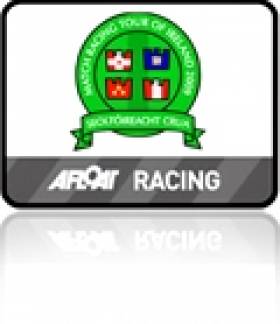Displaying items by tag: Gladiators
Spinnaker on Top in Team Racing National Championships
Last weekend's The Irish Team Racing Association National Team Racing Championships attracted it's largest entry for many years, with 21 teams registered.
The event was hosted by the Fastnet Marine and Outdoor Education Centre in Schull, West Cork.
Four teams travelled over from the UK, and 6 under 19 teams, all from County Cork, competed. They joined the keenest of the post-college teams and the leading university teams to constitute the largest Championships that Ireland has seen for many years. Schull, the venue for next year's World Championship, was a major attraction, but the change of date, from March to November, has made it easier for college students and school pupils to attend.

Weekend Team Racing action from Schull. More photos HERE. Photos: Brian Carlin
The weather forecasts had been predicting storms, floods and general mayhem for days if not weeks beforehand. But Saturday dawned to reveal Schull Harbour in an unusual state – the wind had disappeared! Racing started 3 hours later than planned. However, by the end of the day the first round had been completed. This was a seeded round robin, with each of the four League made up of a UK team, a leading Irish team, a leading college team and two others, including the youth teams.
The results of the first round determined entry into the second round – all the UK teams won all four leagues, with the George Knights, the George Gladiators, Supertroopers and UCD finishing second. These teams were joined in the Gold Leagues of the second round by the winners of play-offs between third place teams. The Bumsby Babes, a youth team from Royal Cork YC, had done well to win 2 races to qualify for a play-off against University of Limerick and they were in a strong position when equipment failure meant that one of their boats retired . In the subsequent re-sail UL managed to win the race and qualify.
On Sunday morning Schull was looking it's best in bright but cold sunshine. Unfortunately, the beauties of the West Cork landscape were exactly mirrored in the unruffled water of the harbour! Competitors, who had made a remarkable effort to arrive on time for an 0900 start, barely recovered from the reception organised the previous evening by the World Championship Committee, waited. When racing eventually got underway, in a fitful breeze, it quickly became obvious that there was no possibility of finishing the second round. Plan B was implemented, a knockout round between the four winners of Round One to determine the outright winner, another between the 4 Irish team placed second in the Round One Leagues to determine the ISA medal places and a Youth round.
GP14 World Champion Ian Dobson in Schull
Spinnaker came through the semis and final to win overall first place. The two Royal St George teams qualified for the final. Last year's winners, the Gladiators won the first race only after finishing places were confirmed by a redress hearing. However, the more experienced Knights went on to win the next to races to reclaim the trophy they had "lent" to the Gladiators last year. The third place play-off, which saw some of the noisiest races of the weekend, resulted in a win by Supertroopers over UCD.
In the Youth event Schull A beat Schull B to win the opportunity to take on, and eventually defeat the Bumsby Babes.
Next year's Championship will be sailed out of the Royal St. George on 12-13 November. However the next challenge for Irish team racers will be qualification for the World Championship, with selection trials planned for both the Youth and Open categories early in 2011.
The event was also the first opportunity to try the new TR3.6 which will be used for the Team Racing Worlds. Video below of the new TR3.6 and voice over from Team Racing World organiser David Harte in Schull. Stills by Brian Carlin HERE.
Sheehy Retains Match Race Title
Dun Laoghiare's John Sheehy retained his National Match Racing Championship title in Kinsale yesterday. The top three teams were: Jodapama Racing (John Sheehy) 2: Mad Match Racing (Ben Duncan) and 3rd: Gladiators (Sam Hunt). Vidcasts with the winners below:
Jodapama Racing have retained their Irish match racing title but had to do it the hard way. Lieing in 4th place over night the pressure was on to make the final and was made worse when they lost the openning race of the second day to Ban Duncan and MadMatch Racing.
After that openning loss John Sheehy, Darragh O'Connor, Paddy Kirwin and Marty O'Leary sailed away from the start area to regroup and came back firing, finishing on 8 wins. Mean while MadMatch kept on racking up points, their final tally topping the table at the end of the round robbin with 9 wins. Prof O'Connell (North Sails Ireland) and Sam Hunt (Gladiators) lead going into day 2 and despite mixed fortunes on day 2 held on to finish on 7 wins a piece to contest the 3rd/4th place play off.
In the 2-0 final Jodapama held pressure off the start in both races to take an early initial lead which they defended to the line despite being put under pressure all the way by MadMatch. 3rd place went to the Gladiators in a nip and tuck 2-1 play-off.
The win also secures Jodapama the Tour title for the second year finishing on 48 points. MadMatch Racing do enough to take 2nd on 29 point with Team Lazarus holding on to 3rd on 26. Gladiators and North Sails Ireland tie on 18 points, with the win in the final race of the play-off giving the Gladiators 4th place on the Tour standings.
























































